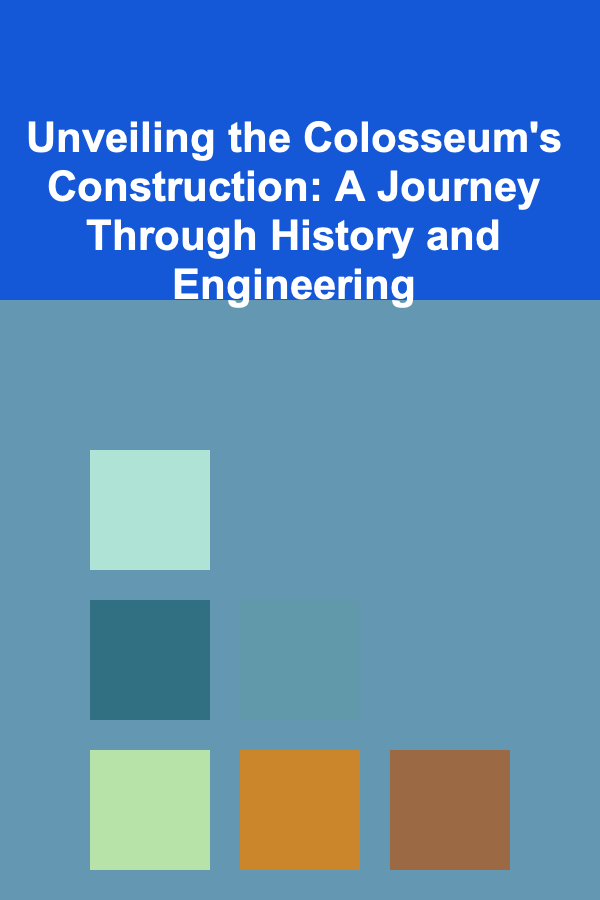
Unveiling the Colosseum's Construction: A Journey Through History and Engineering
ebook include PDF & Audio bundle (Micro Guide)
$12.99$11.99
Limited Time Offer! Order within the next:

The Colosseum, a monumental testament to Roman ingenuity and imperial power, stands as an enduring symbol of ancient Rome. More than just a grand arena for gladiatorial contests and public spectacles, the Colosseum is a complex feat of engineering and logistical planning. Understanding how this massive structure was conceived, designed, and built requires a multi-faceted approach, drawing upon historical accounts, archaeological evidence, and modern engineering analysis.
Historical Context: Vespasian's Ambition and the Flavian Dynasty
The story of the Colosseum begins with the rise of the Flavian dynasty following the turbulent reign of Nero. The year was 69 AD, the 'Year of the Four Emperors,' a period of civil war and instability. Vespasian, a seasoned general, emerged victorious, restoring order and establishing a new imperial line. To solidify his rule and distance himself from the unpopular Nero, Vespasian embarked on ambitious building projects, the most significant of which was the Flavian Amphitheatre, later known as the Colosseum.
Nero's reign was marked by extravagant spending and self-aggrandizement. He had appropriated vast tracts of public land for his Domus Aurea, a lavish palace complex that included an artificial lake. Vespasian, keen to demonstrate a commitment to the Roman people, reclaimed this land and chose the site of Nero's lake for the new amphitheatre. This symbolic act transformed a space of private excess into a public amenity, winning popular support for the Flavian dynasty. Suetonius, in his Lives of the Caesars, emphasizes Vespasian's commitment to public works and his desire to restore Rome to its former glory.
The construction began around 70-72 AD, shortly after the end of the Jewish War, and was largely completed by Vespasian's son, Titus, in 80 AD. Domitian, Titus's brother, later added further refinements and underground structures. Therefore, attributing the Colosseum's construction solely to one emperor is inaccurate; it was a collaborative effort spanning the reigns of three Flavian emperors.
Materials and Labor: The Building Blocks of an Empire
The sheer scale of the Colosseum demanded vast quantities of materials and a massive workforce. The primary building materials included:
- Travertine Limestone: Extracted from quarries in Tivoli, about 20 miles east of Rome, travertine was the primary material for the Colosseum's load-bearing piers, arches, and outer facade. Its durability and strength made it ideal for supporting the enormous weight of the structure. The process of quarrying, transporting, and dressing the travertine stones was a monumental undertaking in itself, requiring skilled stonemasons and a well-organized logistical network.
- Tufa: A volcanic rock, tufa was used extensively in the construction of the Colosseum's interior walls, vaults, and foundations. It was lighter than travertine and easier to work with, making it suitable for less structurally critical elements. Different types of tufa were used depending on the specific application, reflecting a sophisticated understanding of the material's properties.
- Brick-faced Concrete (Opus Caementicium): The Romans were masters of concrete construction, and the Colosseum is a prime example of their expertise. Opus caementicium consisted of a mixture of lime, pozzolana (volcanic ash), and aggregate (broken stones and rubble). This mixture was poured into wooden molds to create walls, vaults, and other structural elements. The brick facing provided a smooth surface and further strengthened the concrete core. The use of concrete allowed for the creation of complex shapes and spaces that would have been difficult or impossible to achieve with traditional stone masonry alone.
- Mortar: Crucial for binding the stones and bricks together, Roman mortar was a carefully formulated mixture of lime, sand, and water. The quality of the mortar was essential for the long-term stability of the structure.
- Iron: Iron clamps and dowels were used to join the travertine blocks and reinforce the concrete structure. These metal elements played a critical role in preventing the stones from shifting or separating over time. Unfortunately, many of these iron components were later pilfered, contributing to the Colosseum's decay.
- Wood: Wood was used for scaffolding, formwork for concrete, and for the arena floor itself, which was covered with sand (arena in Latin). The use of wooden hoists and cranes allowed the Romans to lift heavy materials to great heights.
The labor force involved in the Colosseum's construction was equally impressive. It consisted of a diverse range of workers, including:
- Skilled Stonemasons: These highly trained artisans were responsible for quarrying, dressing, and laying the travertine blocks with precision. Their expertise was essential for ensuring the structural integrity of the amphitheatre.
- Concrete Workers: These workers mixed and poured the concrete, filling the wooden molds and creating the massive walls and vaults of the Colosseum.
- Laborers: A vast army of laborers was needed to transport materials, operate cranes and hoists, and perform other manual tasks.
- Engineers and Architects: These professionals were responsible for designing the Colosseum, planning the construction process, and overseeing the work. While the names of the specific architects involved remain largely unknown, their genius is evident in the amphitheatre's innovative design and engineering.
- Slaves and Prisoners of War: A significant portion of the workforce likely consisted of slaves and prisoners of war, especially after the Jewish War. They were used for the most arduous and physically demanding tasks.
The logistics of supplying this massive workforce with food, water, and shelter were considerable, highlighting the organizational capabilities of the Roman administration.
Design and Engineering: A Marvel of Roman Innovation
The Colosseum's design is a testament to Roman engineering prowess. Its elliptical shape, ingenious seating arrangement, and sophisticated system of underground passages demonstrate a deep understanding of structural mechanics, acoustics, and crowd management.
Structural Design:
- Arcades and Vaults: The Colosseum's structure relies heavily on the use of arches and vaults, which allowed the Romans to create large, open spaces without the need for internal columns. This design principle is evident in the amphitheatre's tiered seating arrangement and its elaborate system of corridors and stairways. The arches and vaults distribute the weight of the structure evenly, ensuring its stability.
- Radial and Circumferential Walls: The Colosseum's structure is based on a system of radial and circumferential walls, which intersect to form a grid-like pattern. This grid provides a strong and stable framework for the entire amphitheatre.
- Keystone Arches: Keystone arches, a hallmark of Roman architecture, were crucial to the Colosseum's stability. The keystone, the central wedge-shaped stone at the apex of the arch, locks the other stones in place, allowing the arch to support a significant amount of weight.
- Foundation: The Colosseum's foundation is a massive concrete slab that extends deep into the ground. This foundation provides a solid base for the entire structure and helps to distribute its weight evenly.
Seating Arrangement:
- Hierarchical Seating: The Colosseum's seating arrangement reflected the social hierarchy of Roman society. The best seats, closest to the arena, were reserved for the emperor, senators, and other high-ranking officials. Lower down, the seats were allocated to knights, ordinary citizens, and slaves. This stratified seating arrangement reinforced the social order and emphasized the power of the ruling elite.
- Vomitoria: The Colosseum was equipped with numerous vomitoria, vaulted passageways that allowed spectators to enter and exit the amphitheatre quickly and efficiently. These vomitoria were strategically located throughout the seating area, ensuring that the audience could disperse rapidly in case of an emergency. The name "vomitoria" suggests the rapid discharge of crowds, like vomiting.
- Awnings (Velarium): To protect spectators from the sun and rain, the Colosseum was equipped with a massive awning called the velarium . This awning was made of canvas and was supported by a complex system of ropes and pulleys. Sailors from the Roman navy were stationed at the top of the Colosseum to operate the velarium, using their nautical expertise to manage the ropes and sails.
Underground Structures (Hypogeum):
- Tunnels and Chambers: Beneath the arena floor lay a complex network of tunnels and chambers known as the hypogeum. This underground structure was used to house gladiators, animals, and equipment. Trapdoors and elevators allowed for the sudden appearance of gladiators and animals in the arena, adding to the spectacle.
- Elevators and Trapdoors: The hypogeum was equipped with a sophisticated system of elevators and trapdoors, which were used to raise and lower gladiators, animals, and scenery into the arena. These elevators were powered by a combination of human and animal labor.
- Drainage System: The Colosseum had an elaborate drainage system that was designed to remove rainwater and waste from the arena and the hypogeum. This system helped to prevent flooding and maintain sanitary conditions.
Construction Techniques: Putting it All Together
The construction of the Colosseum involved a sophisticated combination of traditional Roman building techniques and innovative engineering solutions.
- Quarrying and Transportation: The extraction and transportation of travertine from the quarries in Tivoli was a major logistical challenge. The stones were quarried using a combination of hand tools and wedges, and then transported to Rome by road and river. Ox-drawn carts were used to haul the heavy stones, and barges transported them along the Aniene River to the city.
- Stone Dressing and Placement: The travertine blocks were carefully dressed and shaped by skilled stonemasons using a variety of tools, including chisels, hammers, and saws. The stones were then lifted into place using cranes and hoists. Iron clamps and dowels were used to join the stones together, ensuring their stability.
- Concrete Construction: Roman concrete was a revolutionary building material that allowed for the creation of complex shapes and spaces. The concrete was mixed on site and then poured into wooden molds to create walls, vaults, and other structural elements. The brick facing provided a smooth surface and further strengthened the concrete core.
- Scaffolding and Formwork: The construction of the Colosseum required a vast amount of scaffolding and formwork. Wooden scaffolding was used to provide access to the upper levels of the structure, and wooden formwork was used to mold the concrete into the desired shapes.
- Division of Labor and Project Management: The construction of the Colosseum was a complex project that required a high degree of organization and coordination. The work was divided among different teams of workers, each specializing in a particular task. Project managers oversaw the entire process, ensuring that the work was completed on time and within budget.
Archaeological Evidence: Unearthing the Past
Archaeological excavations and analyses have played a crucial role in understanding the Colosseum's construction. By studying the materials, techniques, and design features of the amphitheatre, archaeologists have been able to reconstruct the building process and gain insights into the lives of the workers who built it.
- Excavations of the Hypogeum: Excavations of the hypogeum have revealed the complex system of tunnels, chambers, elevators, and trapdoors that lay beneath the arena floor. These excavations have provided valuable information about the staging of gladiatorial combats and animal hunts.
- Analysis of Building Materials: Analysis of the travertine, tufa, concrete, and mortar used in the Colosseum's construction has provided insights into the sources of these materials and the techniques used to process them.
- Study of Inscriptions and Graffiti: Inscriptions and graffiti found on the Colosseum's walls provide clues about the people who worked on the building and the events that took place there.
- Survey of Structural Damage: A careful survey of the structural damage to the Colosseum has revealed information about the earthquakes, fires, and other events that have affected the building over the centuries.
Modern Engineering Analysis: A Deeper Understanding
Modern engineering techniques, such as finite element analysis and 3D modeling, can provide a deeper understanding of the Colosseum's structural behavior and its long-term stability. These techniques allow engineers to simulate the effects of stress, strain, and other forces on the building's structure, and to identify potential weaknesses.
- Finite Element Analysis (FEA): FEA is a computer-based technique that is used to simulate the behavior of structures under load. By creating a detailed model of the Colosseum's structure and applying various loads, engineers can analyze the stress distribution and identify areas of potential weakness.
- 3D Modeling: 3D modeling allows engineers to create a virtual replica of the Colosseum, which can be used for a variety of purposes, including visualizing the building's structure, simulating its behavior under different conditions, and creating detailed construction drawings.
- Non-Destructive Testing: Non-destructive testing techniques, such as ground-penetrating radar and ultrasonic testing, can be used to assess the condition of the Colosseum's materials without causing any damage. These techniques can help to identify hidden cracks, voids, and other defects.
Challenges and Controversies: The Ongoing Debate
Despite the wealth of information available, there are still many unanswered questions about the Colosseum's construction. Some of the ongoing debates include:
- The precise role of different emperors in the construction process: While Vespasian initiated the project, Titus completed the main structure, and Domitian added the hypogeum, the specific contributions of each emperor are still debated by historians.
- The number of workers involved in the construction: Estimates of the size of the workforce vary widely, and it is difficult to determine the exact number of slaves, laborers, and skilled artisans who were employed.
- The precise methods used to lift and place the travertine blocks: While we know that cranes and hoists were used, the exact details of these mechanisms are still uncertain.
- The long-term preservation of the Colosseum: The Colosseum has suffered significant damage over the centuries due to earthquakes, fires, and human activity. There is ongoing debate about the best methods for preserving the building for future generations.
Conclusion: A Legacy of Innovation and Grandeur
Discovering the Colosseum's construction is an ongoing process, a continuous dialogue between historical accounts, archaeological findings, and cutting-edge engineering analysis. It is a journey that reveals the remarkable ingenuity, organizational skills, and engineering expertise of the ancient Romans. The Colosseum stands not only as a magnificent monument to the Flavian dynasty but also as a testament to the power of human collaboration and the enduring legacy of Roman civilization. Its construction provides valuable insights into Roman society, economy, and technology, reminding us of the enduring impact of this ancient empire on the world we live in today. The Colosseum remains a powerful symbol of Roman grandeur, a source of fascination and inspiration for generations to come.
"Quae hodie magna dicuntur, olim parva fuerunt." - What are great today, were small once.

How to Clean Your Home's Exterior and Boost Curb Appeal
Read More
How to Involve Everyone in Household Chores Creatively
Read More
How to Perform Routine Checks on Your Home's Security System
Read More
How to Plan for a Comfortable Early Retirement
Read More
How To Shoot Product Videos That Sell
Read More
How to Develop Your Mentoring Skills
Read MoreOther Products

How to Clean Your Home's Exterior and Boost Curb Appeal
Read More
How to Involve Everyone in Household Chores Creatively
Read More
How to Perform Routine Checks on Your Home's Security System
Read More
How to Plan for a Comfortable Early Retirement
Read More
How To Shoot Product Videos That Sell
Read More